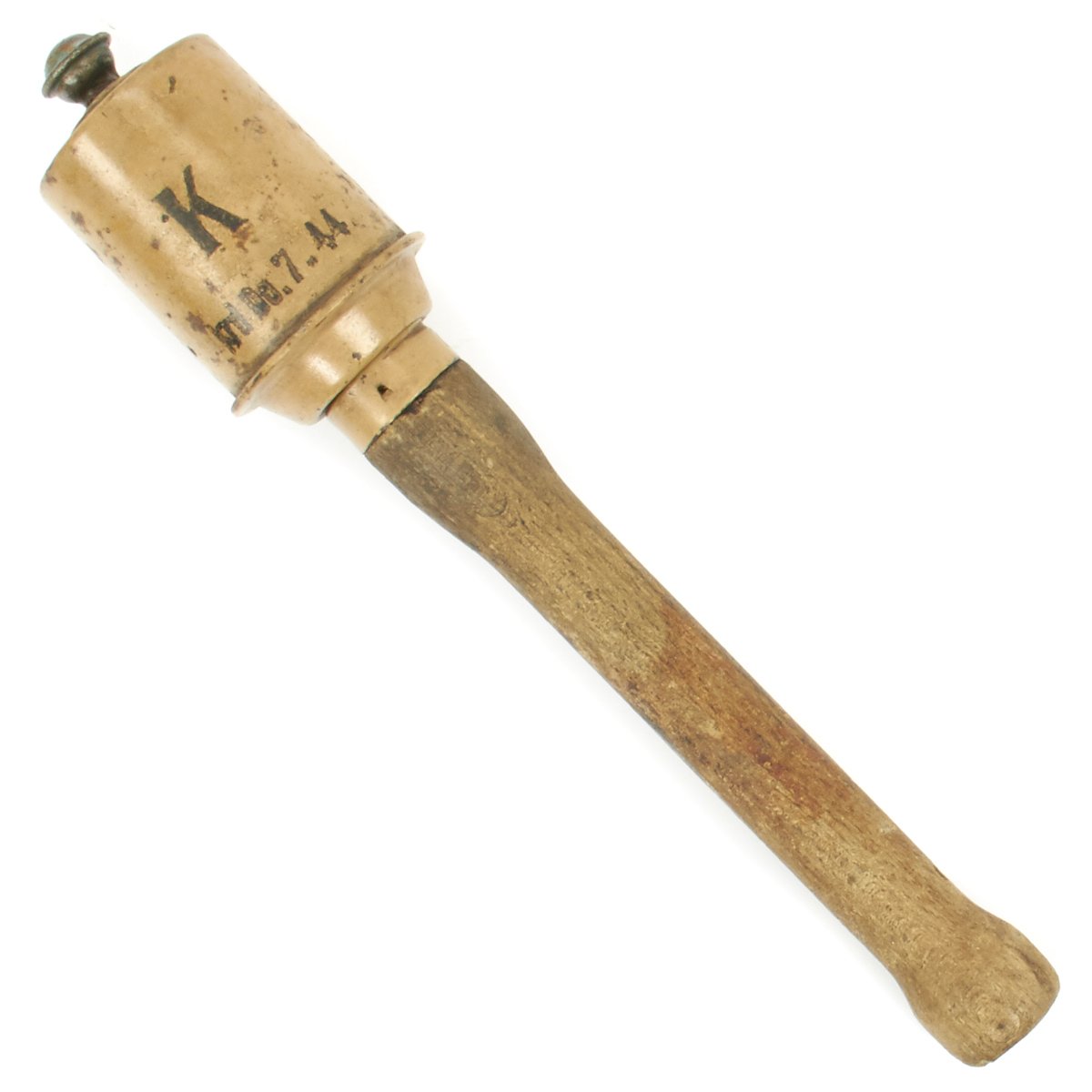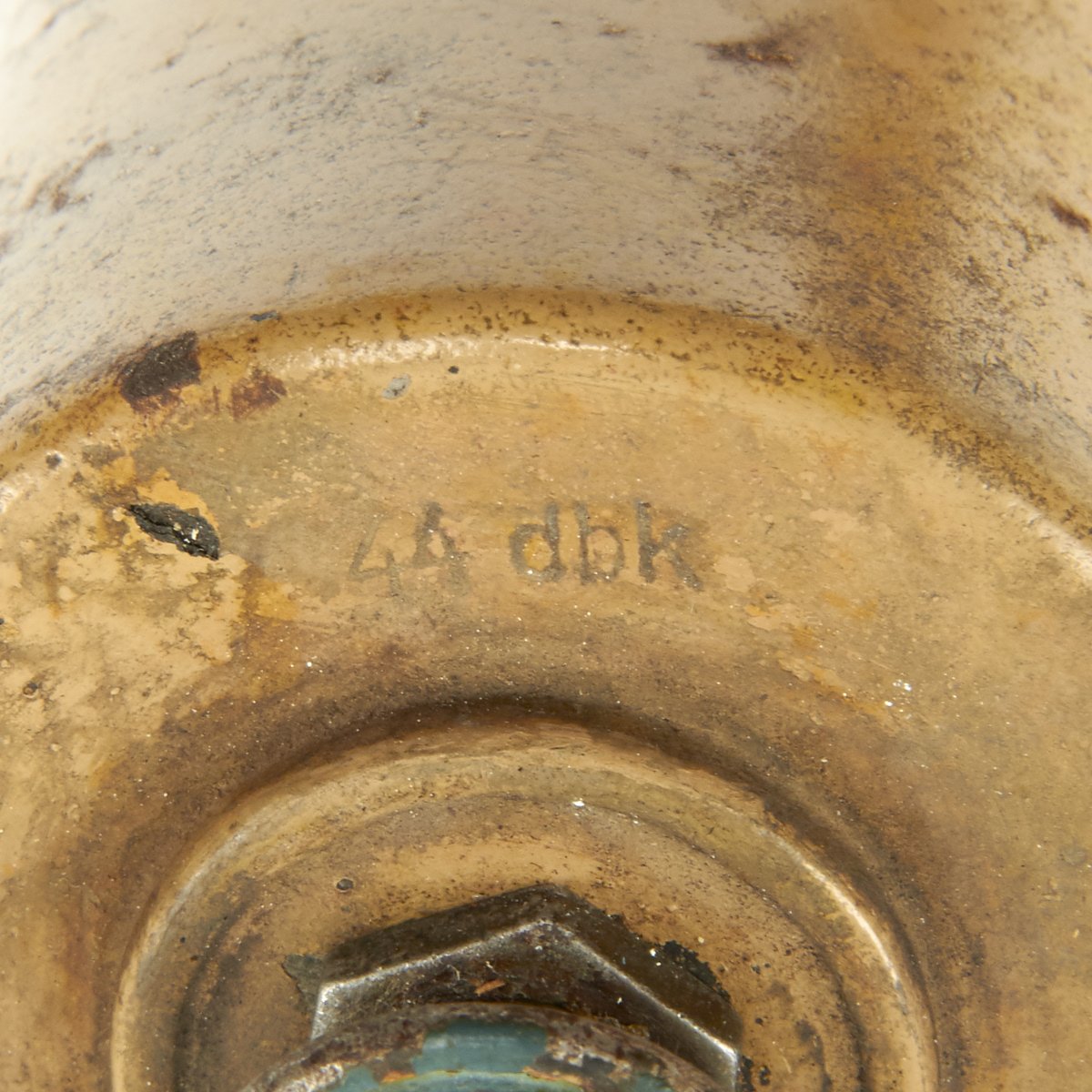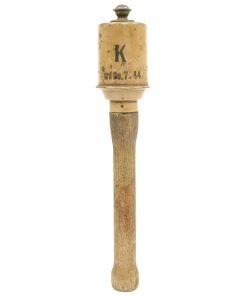Original German WWII 1944 M43 Stick Grenade – Marked dbk 44 Original Items
$ 795,00 $ 238,50
Original Item: Only One Available. This is totally inert ultra rare example of a July 1944 dated Model 1943 Stick Grenade Stielhandgranate 43. This specimen is excellent condition with original tan Dunkelgelb paint and is crisply maker stamped 44 dbk on the top of the head and in black stenciled paint Krd Do 7.1944 on the side of the head which translates to Approved for use in cold weather, filled with Donarit, made in July 1944. The top of the head bears the correct blue painted removable Brennzünder 40 fuze. Overall a fantastic extremely hard to find genuine Stielhandgranate 43 offered in excellent condition!
By 1942 the combined yearly output of all manufacturers of the Stielhandgranate 24 had reached a total of 5,912,000 pieces, but production capacities had reached its limit. Simplifications of the existing design had eased some of the burdens, but they were simply not enough. A whole new design was needed to save both labor hours and raw materials. The simplified model was designated Stielhandgranate 43 and it was announced in the “Heerestechnische Verordnungsblatt” dated 1 May 1944. The production started in 1944 and continued into 1945. The change in production from the Stielhandgranate 24 to the Stielhandgranate 43 must have taken place quite rapidly for all of the manufacturers.
The main modification was the simplified handle. The new handle saved the industry from drilling out 6 million handles yearly and the manufacturing and installation of 6 million safety caps, porcelain balls, strings, rain caps and thread caps each year.
The new handle simply had a metal cap with pressed threads crimped to the end of the handle. Some of these caps can be found painted in Dunkelgelb, but most have a phosphate finish. Most handles, but not all, had a hole drilled through the handle. This detail is not mentioned in the official announcements about the Stielhandgranate 43, so the official purpose is not known, but it would be helpful as an anchorage if the Stielhandgranate 43 was to be used as a booby trap. The lower cover plate of the head was solid with stamped threads set in a well that would accept the handle. The head could be carried and thrown like the Eihandgranate 39 by removing the handle. The detonator channel was no longer attached to a separate lid, but was now spot welded or crimped directly to the top of the head and had internal threads to accept the fuse.
The head was assembled in the same way as the Stielhandgranate 24. The waxed paper bag with the explosives was placed inside the head and the lower cover plate, with the threads for the handle, was crimped in place. Although the constructional drawing shows an additional cover plate in the bottom, inspections of opened surviving examples reveals that this was not installed at the factory.
Apart from the much simplified manufacturing process the new model also had the advantage of much better and easier waterproofing. The head was hermetically sealed and the fuse was screwed into the fuse channel sealing off the access to the Sprengkapseln once installed. The Stielhandgranate 43 was also claimed to be easier to handle, with the fuse in the top of the head.
The Brennzünder 24 was replaced with the Brennzünder für Eihandgranaten 39 with modified wings. The Brennzünder für Eihandgranaten 39 had down folded wings that would follow the contour of the egg, but would not have fitted the head of the new Stielhandgranate 43. The quick-fix was just to turn the wings upside-down. The sole mission of the wings was to assist in the mounting and removing of the fuse.
The Brennzünder für Eihandgranaten 39 worked on the same principle as the Brennzünder 24. Pulling the friction wire through the friction composition contained in the capsule would result in a flame that ignited the delay pellet (black cylinder in the picture above). When the delay pellet burned through, it ignited the detonator.
In December 1944 a new fuse was introduced to replace the Brennzünder für Eihandgranaten 39, the Brennzünder 40. Outwards the fuses looked identical, but the ignition system was completely different. The Brennzünder 40 consisted of a spring loaded striker and a small percussion cap. A strong pull on the rope causes the striker release plate to be drawn from the igniter body, carrying with it the striker and compressing the striker spring. When the release plate is withdrawn fully from the igniter body, it disengages from the striker and the striker is released. The compressed striker spring then forces the striker to impinge upon the percussion cap. The percussion cap will then ignite the delay pellet, burning for 4.5 seconds.
The problem with both the Brennzünder 24, the Brennzünder 39, the Brennzünder 39 (umg.) and the Brennzünder für Eihandgranaten 39 had been the “soft firing”, written as the warning “mit weicher Abfeuerung” on the boxes. The soldier igniting the handgrenade would have no warning to tell him if he had in fact succeeded to ignite the delay pellet, leading to fatal accidents. The new Brennzünder 40 would give off a sharp sound when the striker ignited the percussion cap, actually saving lives! Both the Brennzünder für Eihandgranaten 39 and the Brennzünder 40 had a blue head (Blaukopf), denoting a 4,5 second delay. Different versions of the Brennzünder. Red head (Rotkopf) has a 1 second delay, mostly used in boxes of colored smoke and message boxes dropped from aircraft, but also used in booby traps. Gray head (Graukopf) was instant, used for demolition work, booby traps and ignition of black powder fuses. Blue head (Blaukopf) had a 4.5 second delay, used in different types of handgrenades.The Stielhandgranate 43 was mainly delivered in Dunkelgelb (tan) color.
The markings followed the same pattern as the Stielhandgranate 24, with black ink denoting the explosive contents. “Krd Do 7.1944” should translate to “Approved for use in cold weather, filled with Donarit, made in July 1944”. The maker code and year of production was metal-stamped both to the top and the bottom of the head, and burnt or pressed into the handle. Registered manufacturers of the Stielhandgranate 43 so far includes aqj, bdp., brb, dbk, dol, evy, eyu, fcc, flf, ftd, gck, wc and prd.
Fast Shipping with Professional Packaging
Thanks to our longstanding association with UPS FedEx DHL, and other major international carriers, we are able to provide a range of shipping options. Our warehouse staff is expertly trained and will wrap your products according to our exact and precise specifications. Prior to shipping, your goods will be thoroughly examined and securely secured. We ship to thousands clients each day across multiple countries. This shows how we're dedicated to be the largest retailer on the internet. Warehouses and distribution centres can be located throughout Europe as well as the USA.
Note: Orders with more than one item will be assigned a processing date depending on the item.
Before shipping before shipping, we'll conduct a thorough inspection of the items you have ordered. Today, the majority of orders will be delivered within 48 hours. The delivery time will be between 3-7 days.
Returns
The stock is dynamic and we cannot completely manage it because multiple stakeholders are involved, including our factory and warehouse. So the actual stock may alter at any time. It's possible that you may not receive your order once the order has been made.
Our policy is valid for a period of 30 days. If you don't receive the product within 30 days, we are not able to issue a refund or an exchange.
You can only return an item if it is unused and in the same state as the day you received it. You must have the item in its original packaging.
Related products
Uncategorized
Angolan Rebel 1970s era 60mm Inert Display Mortar from Angolan Civil War Original Items
Uncategorized
Uncategorized
Uncategorized
Armored Burgonet Helmet & Polearm from Scottish Castle Leith Hall Circa 1700 Original Items
Uncategorized
Uncategorized
Uncategorized
Uncategorized
Uncategorized
Uncategorized
Uncategorized
Uncategorized
Uncategorized
Band of Brothers ORIGINAL GERMAN WWII Le. F.H. 18 10.5cm ARTILLERY PIECE Original Items
Uncategorized
Uncategorized
Uncategorized
Uncategorized













































































